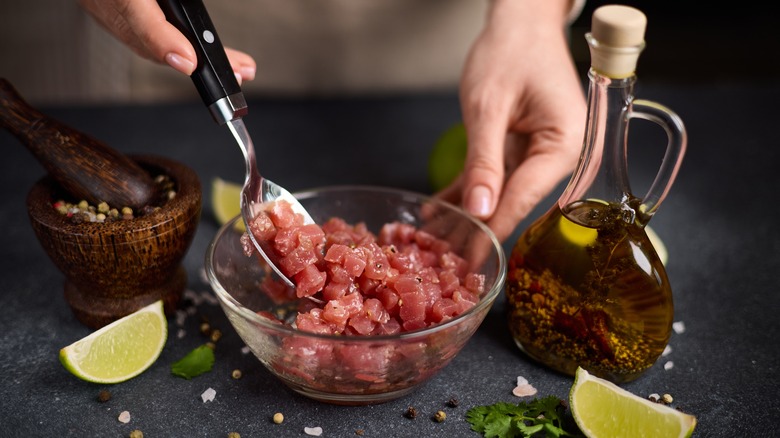Effortlessly Elevate Classic Tuna Tartare With Italian Flavors
A plate of tuna tartare ticks all the boxes for what you want from an appetizer. It's a way to showcase high-quality ingredients and expertly balanced flavors but won't ruin your appetite for the main course. Unlike steak tartare, where the dish takes its inspiration, tuna tartare is a relatively new invention, created by the Japanese-born, French-trained chef Shigefume Tachibe at Los Angeles' Chaya Brasserie in 1984.
It's perhaps because of this origin (or the comparison with tataki) that tuna tartare is often associated with Asian flavors, with many recipes including soy sauce, sesame oil, and ginger. But although tuna has a robust taste, it's essentially a blank slate, and by changing the dressing and adding some extra ingredients, you can completely change the style of the dish.
In this case, we're going to add anchovies, parsley, and chives, along with finely chopped capers that offer bursts of acidity and help cut through the fat of the fish, for a tuna tartare that will be the perfect start to any Italian menu. We're also skipping the soy and instead opting for a dressing of Dijon mustard, olive oil, and lemon juice. We'll then serve the dish with thin slices of toasted baguette and a glass of light Italian red wine.
Tips for the best tuna tartare
As with any raw food recipe, the quality of your ingredients is vital to creating a delicious dish. When serving fish raw, it's generally recommended to opt for sushi-grade or sashimi-grade tuna, but do be aware that this is not a regulated term. It's important to shop at a respected store and be prepared to pay a good price — this is not the dish to make with discount fish.
This is a dish best made fresh before serving, but you can prepare ahead with a simple tweak. Keep the dressing and the chopped tuna separate until serving and coat the fish with a small amount of olive oil, which will keep it from discoloring and maintain that bright pink color. For Italian-style tuna tartare, the olive oil you choose is also important. Opt for a finishing olive oil rather than one made for cooking.
There are other ingredients you can add to conjure up the feeling of a summer's day in Italy: Try chopped sundried tomatoes, fermented Italian chili, or basil leaves added to your dressing, or for a more substantial dish, top the tuna with stracciatella or burrata.

